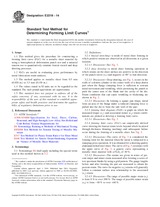Potřebujeme váš souhlas k využití jednotlivých dat, aby se vám mimo jiné mohly ukazovat informace týkající se vašich zájmů. Souhlas udělíte kliknutím na tlačítko „OK“.
ASTM E2218-14
Standard Test Method for Determining Forming Limit Curves
Automaticky přeložený název:
Standardní zkušební metoda pro stanovení tváření Mezní křivky
NORMA vydána dne 1.4.2014
Informace o normě:
Označení normy: ASTM E2218-14
Poznámka: NEPLATNÁ
Datum vydání normy: 1.4.2014
Kód zboží: NS-44697
Počet stran: 15
Přibližná hmotnost: 45 g (0.10 liber)
Země: Americká technická norma
Kategorie: Technické normy ASTM
Anotace textu normy ASTM E2218-14 :
Keywords:
circle grid, forming limit curve (FLC), forming limit diagram (FLD), limiting dome height (LDH), major strain, minor strain, strain analysis, ICS Number Code 77.040.20 (Non-destructive testing of metals)
Doplňující informace
| Significance and Use | ||||||||||||
|
5.1 A forming limit curve (FLC) defines the maximum (limiting) strain that a given sample of a metallic sheet can undergo for a range of forming conditions, such as deep drawing, stretching and bending over a radius in a press and die drawing operation, without developing a localized zone of thinning (localized necking) that would indicate incipient failure. 5.1.1 FLCs may be obtained empirically by using a laboratory hemispherical punch biaxial stretch test and also a tension test to strain metal sheet specimens from a material sample beyond their elastic limit, just prior to localized necking and fracture. 5.1.1.1 Since this cannot be predetermined, one or both surfaces of specimens are covered with a grid pattern of gauge lengths usually as squares or small diameter circles, by a suitable method such as scribing, photo-grid, or electro-etching, and then each specimen is formed to the point of localized necking, or fracture. 5.1.2 Strains in the major (5.1.2.1 Blanks of varied widths are used to produce a wide range of strain states in the minor (5.1.2.2 The major (e1) strain is determined by the capacity of the material to be stretched in one direction as simultaneous surface forces either stretch, do not change, or compress, the metal in the (e 2) direction. 5.1.2.3 In the tension test deformation process, the (e2) strains are negative and the metal is narrowed both through the thickness and across its width. 5.1.3 These strains are plotted on a forming limit diagram (FLD) and the forming limit curve (FLC) is drawn to connect the highest measured (e1 and e2) strain combinations that include good data points. 5.1.3.1 When there is intermixing and no clear distinction between good and necked data points, a best fit curve is established to follow the maximum good data points as the FLC. 5.1.4 The forming limit is established at the maximum (e1) strain attained prior to necking. 5.1.5 The FLC defines the limit of useful deformation in forming metallic sheet products. 5.1.6 FLCs are known to change with material (specifically with the mechanical or formability properties developed during the processing operations used in making the material), and the thickness of the sheet sample. 5.1.6.1 The strain hardening exponent (n value), defined in Test Method E646, affects the forming limit. A high n value will raise the limiting major strain (e1), allowing more stretch under positive (+e2) strain conditions. 5.1.6.2 The plastic strain ratio (5.1.6.3 The thickness of the material will affect the FLC since a thicker specimen has more volume to respond to the forming process. 5.1.6.4 The properties of the steel sheet product used in determining the FLC of Fig. 3 included the n value and the 5.1.7 FLCs serve as a diagnostic tool for material strain analysis and have been used for evaluations of stamping operations and material selection. 5.1.8 The FLC provides a graphical basis for comparison with strain distributions on parts formed by sequential press operations. 5.1.9 The FLC obtained by this method follows a constant proportional strain path where there is a fixed ratio of major (e1) to minor (e2) strain. 5.1.9.1 There is no interrupted loading, or reversal of straining, but the rate of straining may be slowed as the specimen approaches neck-down, or fracture. 5.1.9.2 The FLC can be used for conservatively predicting the performance of an entire class of material provided the n value, 5.1.10 Complex forming operations, in which the strain path changes, or the strain is not homogeneous through the metal sheet thickness, may produce limiting strains that do not agree with the forming limit obtained by this method. 5.1.11 Characterization of a material's response to plastic deformation can involve strain to fracture as well as to the onset of necking. These strains are above the FLC. 5.1.12 The FLC is not suitable for lot-to-lot quality assurance testing because it is specific to that sample of a material which is tested to establish the forming limit. |
||||||||||||
| 1. Scope | ||||||||||||
|
1.1 This method gives the procedure for constructing a forming limit curve (FLC) for a metallic sheet material by using a hemispherical deformation punch test and a uniaxial tension test to quantitatively simulate biaxial stretch and deep drawing processes. 1.2 FLCs are useful in evaluating press performance by metal fabrication strain analysis. 1.3 The method applies to metallic sheet from 0.5 mm (0.020 in.) to 3.3 mm (0.130 in.). 1.4 The values stated in SI units are to be regarded as the standard. The inch-pound equivalents are approximate. 1.5 This standard does not purport to address all of the safety concerns, if any, associated with its use. It is the responsibility of the user of this standard to establish appropriate safety and health practices and determine the applicability of regulatory limitations prior to use. |
||||||||||||
| 2. Referenced Documents | ||||||||||||
|
Doporučujeme:
Aktualizace technických norem
Chcete mít jistotu, že používáte pouze platné technické normy?
Nabízíme Vám řešení, které Vám zajistí měsíční přehled o aktuálnosti norem, které používáte.
Chcete vědět více informací? Podívejte se na tuto stránku.




 Cookies
Cookies
